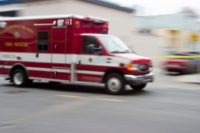The accident that killed four workers at two different companies in St. Louis, Missouri last week occurred when a 3,000 lb. storage tank launched 425 feet into the air at a speed of 120 mph before crashing down – with devastating results – according to U.S. Chemical Safety Board (CSB) investigators.
The vessel that exploded upward from the Loy-Lange Box Co. and landed nearby in the Faultless Linen building was a vertical condensate storage tank, technically referred to as the SCR or semi-closed receiver. The SCR provided the condensate or hot water to a steam generation and supply system supporting a corrugated box manufacturing process. That process was being started up on the morning of the incident. Initial visual examination suggests that the bottom pressure boundary of the SCR failed.
The CSB says it will conduct a more thorough inspection of the SCR unit once it’s removed from the building.
What the agency knows now: the SCR contained about 510 gallons of water and was operated at about 330°F and 100 psig. The SCR itself is roughly 20 to 25 feet tall and about 3 feet in diameter and about 3000 lbs.
When the vessel failed, the hot condensate jetted from the bottom, converting from hot water to steam. The power of the jet of water rapidly turning to steam broke the vessel loose from its piping attachments and fastenings, propelling it through the internal structure and roof of the building. The downward force of the steam sent the vessel into the air, where it remained airborne for over 10 seconds. It traveled 515 feet from its starting point.
The victims have been identified as 59-year-old Loy-Lange employee Kenneth Trentham. News reports said two of the fatalities at Faultless Healthcare Linen, 43-year-old Tonya Gonzalez-Suarez and 46-year-old Christopher Watkins were married. Two other workers -- one from each company -- are hospitalized with serious injuries.
The structural integrity of both buildings is still being assessed. One crew was able to enter an area deemed safe at the Loy-Lange facility to 3-D photo-document the scene. This information will be used to further assess the site and determine next steps to stabilize the building and the location of potential evidence.
Protocols to remove the SCR from the Faultless building are also being developed. The failure mode of the SCR is unknown at this early stage in the assessment, however, in cases of vessel failure it is typical for the CSB to examine issues of vessel operation, preventive maintenance, and mechanical integrity.
The CSB is an independent federal agency whose mission is to drive chemical safety change through independent investigations to protect people and the environment. The agency’s board members are appointed by the President and confirmed by the Senate. CSB investigations look into all aspects of chemical incidents, including physical causes such as equipment failure as well as inadequacies in regulations, industry standards, and safety management systems.


